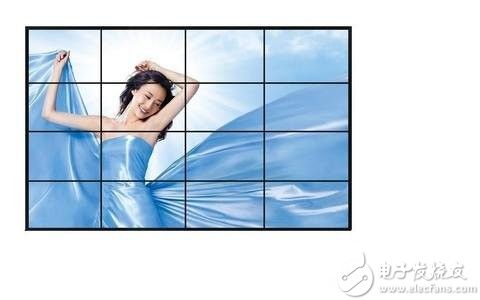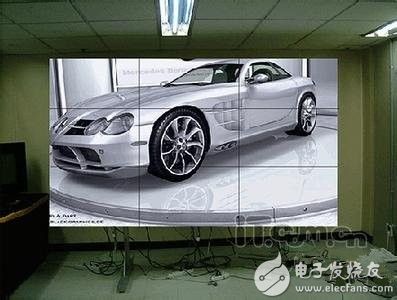With the improvement of information technology, people are increasingly demanding visual appreciation. "Visual impact" has become a standard for people to judge display performance. Visual impact comes not only from a clear picture, but also from an oversized picture. In order to meet this demand, large-screen splicing came into being. In addition, edge fusion technology based on projection technology is also available for large screens. From the current situation, in the application of super-large images, the various technologies are "all in each eye" and play various advantages in different fields. First, the large screen splicing system At present, the relatively common large-screen splicing system is generally divided into three main types according to the working mode of the display unit, namely, LCD display unit splicing, PDP display unit splicing, and DLP rear projection display unit splicing. The former two belong to the flat panel display unit splicing system, and the latter belong to the projection unit splicing system. 1, plasma large screen splicing system PDP (Plasma Display Panel), which is a plasma display. PDP is a display technology that uses gas discharge and works like a fluorescent lamp. It uses a plasma tube as a light-emitting element. Each plasma tube on the screen corresponds to one pixel. The screen uses glass as a substrate, and the substrates are separated by a certain distance to form a discharge space. The discharge space is filled with a mixed inert gas such as helium or neon as a working medium, and a metal oxide conductive film is coated on the inner surface of the two glass substrates as an excitation electrode. When a voltage is applied to the electrode, a plasma discharge phenomenon occurs in the mixed gas in the discharge space, which is also called a plasma effect. The plasma discharge generates ultraviolet light, and the ultraviolet light excites a fluorescent screen coated with red, green and blue phosphors, and the fluorescent screen emits visible light to reveal an image. PDP unit splicing has the advantages of bright color, high contrast and high brightness, and it also has its own insurmountable shortcomings. Due to the large amount of electricity and heat generated, plasma can cause serious burns and is not suitable for long-term static display monitoring. And after the PDP unit is used for splicing, the whole machine heats up higher, which makes the device easy to burn. In addition, the current market price of plasma splicing curtain wall is relatively high, generally the price of one square meter is as high as 100,000. Today, low carbon and energy saving have become the mainstream trend. For most ordinary users, plasma splicing is obviously not the best choice. Despite the many shortcomings, the bright color and high brightness of the plasma make the display effect of the screen have outstanding advantages, which makes plasma splicing become the darling of some exhibition activities. In addition, plasma is also preferred for government agencies that require high picture quality. However, from the overall market share, plasma splicing is at a complete disadvantage, and the development potential of plasma splicing is limited in terms of the development trend of the whole industry. According to some industry insiders, the industry is currently a “chicken rib industry†and will definitely be replaced in the future. 2, LCD LCD stitching The so-called LCD liquid crystal large-screen splicing is a splicing screen body that realizes large-screen display effect by splicing control software system by means of splicing of LCD display unit. LCD LCD splicing is currently represented by Samsung's DID in South Korea. Although there are SHARP, LG, NEC and other brands in the splicing market, DID stands out in LCD flat panel splicing technology with its excellent cost performance. LCD splicing has the advantages of thin thickness, light weight, low energy consumption, long life, no radiation, and its fine picture and high resolution. The excellent performance of various key performance indicators has made it the mainstream of development and the prospect is promising. As a splicing display terminal, although the LCD has the above advantages, as a splicing display unit, its disadvantage is also fatal: that is, its seams are currently large, and the largest among the three spliced ​​display units, so many users have to bear with pain. Edge blending technology has the following advantages: 1, increase the image size; the integrity of the picture The images projected by multiple projectors must be larger than the size projected by a single projector; the bright and beautiful images can bring people different visual impacts, and the seamless edge fusion technology is used to stitch together. The picture should largely guarantee the perfection of the picture and the consistency of the color. 2, increase the resolution Each projector projects a portion of the entire image so that the resulting image resolution is improved. For example, the physical resolution of a projector is 800 x 600, and after the two projectors are blended by 25%, the resolution of the image becomes 2000 x 600. 3, ultra high resolution With an image processor and computer with multi-channel high-resolution output, composite images of three or more channels of 1600x1200 pixels per channel can be produced. If you blend 25% of the pixels, you can subtract 4000 x 1200 resolution images from the overlapping pixels. There are currently no standalone displays on the market that can operate at such high resolutions. The solution is to use a projector matrix, each projector running at its maximum resolution, and the combined resolution is the sum of the pixels after the overlap region is subtracted. 4, shorten the projection distance With the advent of seamless stitching, the shortening of the projection distance becomes inevitable. For example, the original 200-inch (4000x3000mm) screen, if there is no physical and optical seam, we can only use one projector, projection distance = lens focal length x screen width, using a light angle lens 1.2:1, our projection The distance is also 4.8 meters. Now, we have adopted the technology of melting edge. There are no seams in the same picture. Our distance only needs 2.4. 5, special shape on-screen projection imaging For example, if you project a picture on a cylindrical or spherical screen, a single projector needs a long projection distance to cover the entire screen, and the combination of multiple projectors can not only make the projected image larger, but also reduce the projection distance. The chord is shortened to as small as possible, which is a better choice for image resolution, brightness and aggregation. 6, increase the picture layering Thanks to the edge blending technology, the resolution and brightness of the image are enhanced, and at the same time, with the high-quality projection screen, the image layering and expressiveness of the entire display system is significantly enhanced. Edge blending is a set of projections from a projector for edge overlap, so in theory, the image displayed using edge blending can be infinite and clear. Large-screen splicing will be more difficult, both technically and spatially, as the display expands. Therefore, in particular, the edge fusion technology is more suitable for places with larger space, that is, so-called large space clear application. Conclusion Experts in the projection era believe that LCD splicing can be said to be the sunrise power of the large screen field. As the technology continues to mature, the shortcomings of LCD joints will be improved, and its outstanding advantages will be more perfect, and the price of LCD screens has been falling, and its operating costs will continue to decrease. In the future, LCD splicing will become the dominant force in large-screen splicing. Airis Vape,Airis Mega 2000Puffs,Airis Max 1800Puffs,Airis Chief 2600Puffs Shenzhen Zpal Technology Co.,Ltd , https://www.zpal-vape.com

